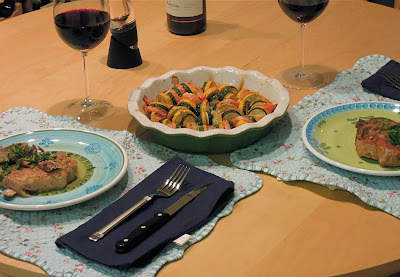I love the taste and texture of shortbread cookies. They are crisp on the outside but buttery and crumbly on the inside. Shortbread is a classic Scottish dessert that consists mainly of the following three ingredients: sugar, butter and flour. While I was researching other shortbread recipes, I noticed that some called for rice or cornflour and shortening. This gives a different texture to the cookie - crispier or softer depending on the type of flour and amounts used. But if you know me, I like to keep things simple and classic, which is why my shortbread recipe is made with those top three ingredients and vanilla, of course.
The shortbread recipe is adapted from
Claire Clark, the former pastry chef at Thomas Keller's famous French Laundry. When we visited The French Laundry a couple years ago, we got a bag of shortbread cookies as favors after the meal. Those were the best shortbread cookies I have ever had and when I found her pastry cookbook, I was ecstatic. Obviously, the shortbread cookies were the first thing I made from that book. Claire's recipe was actually from her mother. I personally love recipes that are passed down from generation to generation. It brings a sense of nostalgia and tradition to the people making and those enjoying them. In her book and at the French Laundry, she cut her shortbread into oblong shapes, which looks more traditional. Because I wanted to make shaped cookies from the shortbread, I altered some steps in her recipe.
1. Preheat oven to 350 degrees F or 180 degrees C.
2. Cream the butter, sugar and flour until it resembles a coarse meal. You can use your hands to rub the butter into the dry ingredients. I just think it's a lot easier to use a mixer.
3. Add vanilla and continue to beat the batter to mix.
4. The dough will look and feel crumbly, but don't worry it will come together. Shape the dough into a ball and flatten it. Roll the dough to about 1/4 inch thick and cut with your favorite cookie cutter.
5. Chill the cut cookies in the refrigerator for 20 minutes. This will help retain it's shape when it is baked in the oven.
6. Bake them in a preheated oven for 15 minutes, then turn the baking sheet around and continue baking for another 10 minutes, or until the shortbread is golden brown. One way to tell that your shortbread is done is by looking at the edges of the cookie. It will be slightly brown and crisp. Remove from oven and let cool completely before icing. If you decide not to ice the shortbread, simply dust some granulated sugar on top of the cookie when they come out of the oven. Let cool and serve. They are equally delicious at this stage.
Recipe for shortbread:
It is best if you weigh the recipe, but if you don't have a weighing scale, I've converted the measurement to 'cups'. This recipe yields about 40 cookies, depending on the size.
337.5g or 2 2/3 cups of plain flour
112.5g or 2/3 + 1/4 cup granulated sugar
225g or 2 sticks of butter at room temperature
1 tbsp of vanilla
granulated sugar for dusting
If you decide to ice the cookies, here's how I did it. But first, a low down on a couple types of icing.
Piping icing:
The consistency for piping icing is similar to toothpaste. Because you are using this for outlines, you want it to flow easily, in a straight-line without breaking or cracking. You want to make sure that it is not too thin (watery) that it is hard to draw outlines on the cookie (it will drip off the sides of the cookie).
Flood icing:
Once the outline dries, you want to "flood" the inside of the cookie with a thinner icing. Simply add water to the basic royal icing to thin it out. When you lift the beater up, it should flow back into the pool of icing slowly, like a stream.
Recipe for Icing:
2 egg whites (you can also use pasteurized egg whites)
2 tsp lemon juice
About 3 cups of powdered sugar. You may need more if the icing is too wet.
Water, as necessary
Beat the egg whites and lemon juice together for a few seconds. Then add the powdered sugar, a tablespoon at a time until you reach the appropriate icing consistency. I started off by making the flood icing first. That way, I can divide the mixture when the flood icing is done and leave the rest to make the piping icing by adding more powdered sugar. The color of the icing is glossy and white. Add colors, if desired. I used yellow and white for the shortbread cookies.
Pipe an outline around the border of the cookie and let dry.
Once the outline dries, "flood" the inside of the cookie with thinner icing. I spread the icing, making sure I cover the entire cookie with the back of a spoon. You can also use a toothpick. Sometimes, air bubbles will form, so just use a toothpick to poke the air bubble. The 'flood' icing is made by simply adding water to 'piping icing', a teaspoon at a time. If you had accidentally added too much water, don't worry. You can thicken it by adding more powdered sugar, till you reach the right consistency.
Once the icing dries, I piped a border around the cookie again and the buds in the middle. Let dry.
 |
| Shortbread Flower cookies. |
I packaged my cookie with some edible green apple candy 'grass' that I bought from Target in a glassine bag and topped it with a ribbon.
Happy Spring!
























































